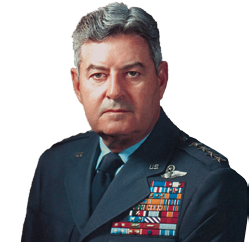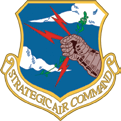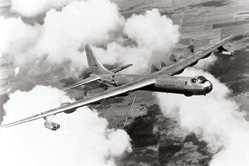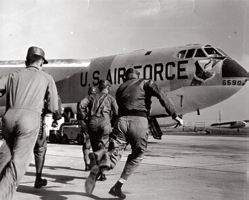When the Soviets blockaded Berlin in June 1948 and war seemed imminent, the Joint Chiefs of Staff asked the commander of Strategic Air Command (SAC), General George Kenney, to brief them on his unit’s readiness.
The briefing did not go well: Kenney appeared ill informed. The Air Force chief of staff, General Hoyt Vandenberg, then asked an old friend, Charles Lindbergh, to inspect SAC and evaluate its competence and abilities. Two weeks later, Lindbergh reported that SAC was unprepared and lacking in basic skills: “Personnel are not sufficiently experienced in their primary mission.”1 Vandenberg relieved Kenney and replaced him with Lieutenant General Curtis E. LeMay.

The Man
Born in Columbus, Ohio, LeMay was commissioned through the Reserve Officer Training Corps in 1928 as he worked toward an engineering degree at Ohio State University. He won his wings the following year and, in 1936, arrived at the 2nd Bombardment Group at the same time as the new YB-17s.
Over the next decade, he became known as one of the best navigators and pilots in the Air Corps. In 1937, he located the battleship Utah in exercises off California and “bombed” it with water canisters. The following year, he navigated B-17s 600 miles out to sea to intercept the ocean liner Rex, illustrating airpower’s ability to defend American coasts.
In 1938 LeMay led B-17s to South America to display airpower’s role in hemisphere defense. War brought rapid promotion. At the beginning of World War II, LeMay served as a group commander in the Eighth Air Force but in 18 months had progressed to major general. He led from the front while also earning a reputation as an innovative tactician and problem solver.
In December 1944, LeMay took over XXI Bomber Command in the Mariana Islands. From there, he planned and conducted the decisive B-29 bombing campaign against Japan.
When the war ended, LeMay served on the Air Staff as the deputy chief of staff for research and development. He then moved to Germany to become commander of United States Air Forces in Europe, where he was at the time of the Berlin blockade.
Vandenberg was impressed by LeMay’s ability to get things done. When the chief needed a new leader at SAC, LeMay was the obvious choice; he possessed an indomitable will and an unshakeable faith in the efficacy of strategic airpower.
LeMay’s personality was the subject of frequent caricature. Yes, he was unsophisticated, taciturn, and tactless, but he was also hard working and courageous. He led his bomb group on the bloody Schweinfurt- Regensburg mission of August 1943, and during his tenure as SAC commander, he stated that if his men went to war, then he would be in the first plane.

At the same time, he was sincerely concerned about his troops and labored to improve their food, housing, and recreation facilities. In the austere areas where many SAC bases were located, these amenities were important.
In one letter, LeMay noted that “pay alone is not a primary incentive... There must be a vital concern throughout SAC [for] individual consideration and firm personal guidance for our airmen.”2
LeMay believed that people wanted to work hard but needed encouragement and recreational opportunities to recharge their batteries. For his part, he loved hunting, fishing, and working on cars. He wanted all SAC bases to have an auto hobby shop for the benefit of others like him who found relaxation in overhauling a car engine. LeMay also pushed hard for better housing.
Although hundreds of air bases had been built during the war, these temporary facilities were of substandard construction. To him, openbay barracks for enlisted troops were an outdated concept; he wanted Airmen in dormitories—two to a room—to give them a better lifestyle. When the Corps of Engineers objected, LeMay hired local contractors to build them. He asked a group of wives to select colors, drapes, and furniture to make the dorms more livable.
For married families, LeMay worked with Senators Kenneth Wherry and Homer Capehart to fund low-cost base housing. Although LeMay seemed tough and uncompromising, those who knew him best said he had a soft heart. He seldom became visibly angry or raised his voice. He cared about people and their welfare—but the mission came first.
One of LeMay’s comments regarding someone relieved because of an unfortunate accident was typical, “I can’t tell the difference between unlucky and unskilled because the results are the same.”3
Above all, he demanded results. LeMay used his staff effectively, seldom giving detailed directives but providing subordinates the authority to use their own judgment. The operations analysis chief at SAC watched him for nine years and concluded that his management style worked: LeMay’s reliance on the people he selected for senior positions [allowed] him time to be available on short notice. By concentrating on basic strategies and major decisions, while depending on his staff to formulate them, he escaped the trap of a bulging schedule that would have made mature planning difficult. As a result, he was able to stay in complete control of SAC’s operations, while being one of the most available persons in the headquarters.4
The stories told of LeMay and quotations attributed to him are legion. Although most are apocryphal, they were widely circulated and added to his mystique. He once entered a hangar and found it guarded only by an Airman with a ham sandwich. He drove through a gate at one SAC base without stopping; the gate guard pulled out his sidearm and shot at the car. LeMay slammed on the brakes, got out, and berated the cop—for missing.

Convair B-36 Peacemaker showing four General Electric J-47 jet engines mounted under outer wings in pairs, combined with six Pratt & Whitney piston engines mounted as pushers. (U.S. Air Force Photo)
One day he grew suspicious of a telephone repairman in his office; he pulled out his .45 and held the man prisoner until the air police arrived. At one of his bases, a guard found an intruder in the nuclear weapons storage area, ordered him to halt, and then fired a warning shot. When the individual kept running, he shot and killed the man. The wing commander called LeMay and asked for guidance on how to handle the situation. LeMay told him to make the sky cop pay for the bullet he wasted on the warning shot.
When asked whom he favored in an upcoming Army-Navy football game, he growled, “I hope they both lose.”
A cigar became his trademark. (LeMay had Bell’s palsy, a malady that affects the facial muscles, making it difficult to keep the mouth from sagging. He usually had a cigar in his mouth to help strengthen those muscles.) While the general was standing next to a bomber being refueled, a maintenance officer asked him to extinguish his stogie before it blew up the entire base. LeMay’s reply was, “It wouldn’t dare.”
When someone called him a tough guy, he retorted that he didn’t mind: He found that in his business, the tough guys led the survivors. He needed to be tough to deal with the many challenges facing his command.
Reforging the Weapon
One LeMay legend concerns “the attack on Dayton.” After taking over at SAC, he met with his commanders and staff and realized they “weren’t worth a damn.” He announced an alert—a maximum effort of all bombers to carry out a simulated attack on Dayton, Ohio.
The strike would occur from high altitude, at night, using radar bombing techniques. According to LeMay, not one aircraft completed the mission as briefed.5 The SAC history is not quite that damning, but it notes that the results of the mock attack were poor: Of 15 B-36s scheduled in one bomb group, six aborted and three others failed to “drop” over the target due to radar malfunctions.
The story was the same in other groups. Bombing accuracy was awful, with an average miss distance of two miles.6 LeMay had made his point. The general then began to strip down the command and remake it, reshuffling the three numbered air forces. It made no sense to have a bomb wing in Florida assigned to Fifteenth Air Force, headquartered in California.
The air forces also had been organized along functional lines: The Eighth had mostly B-50s, while the Fifteenth primarily flew B-29s; Second Air Force contained reconnaissance assets. LeMay transformed all three into composite units with a mix of very heavy bombers (the new B-36s coming online), mediums (B-29s and B-50s), a reconnaissance wing, and fighter escorts. This commonsense reorganization saved money, cut communication and travel time, and allowed better training.
Bombing accuracy was a major concern. LeMay directed that exercise targets be changed frequently—as were aim points, altitudes, and run-in headings—to prevent crews from becoming too familiar with training routines and thereby inflating bomb scores. Radar reflectors to aid bombardiers were prohibited.
At the same time, crews used detailed radar surveys of U.S. cities as training guides. Radar bomb-scoring (RBS) detachments were deployed throughout the United States using sophisticated wind-measuring instruments and radar to determine the accuracy of simulated bomb drops.
The use of RBS increased dramatically under LeMay: In 1946 SAC logged 888 radar bomb runs; in 1950 that number leapt to 43,722. The radar specialists also realized they could do more than measure results; they could assist a crew’s bombing effort.
During the Korean War, these teams deployed to Korea to aid B-29s on their bombing missions. Readiness tests had been instituted in early 1948, but LeMay refocused them to emphasize flying, radar bombing, the in-commission rate of aircraft, and the ability to sustain a maximum effort over a period of several days.
This marked the birth of the dreaded operational readiness inspections (ORI), during which teams would fly into a SAC base unannounced and tell the wing commander to assume that war had broken out and to execute the war plan.
In addition, bombing competitions were held annually. Crews from each bomb group would drop a series of simulated bombs from high altitude using radar. The winning crews returned home as heroes.

Photo of a SAC B-52 crew scrambling for their B-52 during an alert exercise.
Rivalry between the wings grew, and so did morale. One initiative, the Lead Crew School, sought to improve SAC bombing accuracy. LeMay had instituted such programs during World War II and decided to replicate the practice in SAC.
In June 1949, he established SAC’s Lead Crew School at Walker AFB in New Mexico. There, crews trained together in a standardized and uniform pattern. Each wing sent three crews to each class, and the school soon established an excellent reputation—after eight cycles, bomb scores had improved by more than 50 percent. These crews then returned to their units to instruct the other crews on what they had learned, slowly but noticeably improving the performance of the entire command.
In December 1949, LeMay pushed through another radical idea— spot promotions. He met with General Idwal H. Edwards (deputy chief of staff for personnel) and General Vandenberg, convincing them to allow him to promote lead crew members “on the spot” to the next grade. Crews that won bomb competitions would receive promotions as well. LeMay intended to improve morale, give everyone a heightened sense of purpose and competition, and validate SAC as the premier organization in the Air Force.
He recognized that this practice would cause irritation outside SAC, so he made it clear that spot promotions would be based on merit and continued outstanding performance: “I intend to make an example of the first officer I find who has relaxed now that he has made temporary captain as a crew member.” If someone failed a check flight, then all crew members would lose their spot promotions.7
Studies of war plans that assumed a major conflict with the Soviet Union spearheaded by an atomic strike employing SAC bombers raised the question of covering the long ranges to and from targets deep in Russia. Other investigations showed that bases in Europe were highly vulnerable to a Soviet first strike.
Instead, LeMay pushed hard for air refueling. Based on his experience in research and development after the war, the general became a firm believer in advanced technologies. He wanted the jet-powered, long-range B-52s. But even these aircraft would need air refueling to reach their targets and return.
B-29s and C-97s were modified to serve as tankers, but as the new jet bombers came online, these piston-driven tankers could not keep up. The Boeing KC-135 offered a solution, and LeMay ordered more than 700 of these “Stratotankers,” hundreds of which are still in service.
The Leader
Contrary to some depictions, Curtis LeMay neither rejected scientific thinking nor resented the introduction of civilian academics into what had been the military’s preserve. Indeed, because of his support in this area, one historian refers to him as the “godfather” of RAND—the California-based think tank that to this day performs important work for the Air Force.8
The nuclear war theorists used impeccable logic in devising their scenarios regarding deterrence, assured destruction, and related concepts. To LeMay, such theories were of limited use. War had its own logic, and it was not as predictable as civilian academics believed. If logic were the key to strategy, then the Japanese would never have been so foolish as to attack Pearl Harbor in 1941.
LeMay appreciated the efforts of these academics but realized that he, as the commander, was responsible for results. The professors at RAND and elsewhere could provide some good ideas—but the buck stopped at SAC. It would be the unit going to war, and LeMay never forgot that.
By the mid-1950s, SAC had reinvented itself, and over it all stood Curtis LeMay. He pinned on his fourth star in 1951, one month prior to his 45th birthday (the second-youngest full general in American history behind U. S. Grant). His insistence on performance and professionalism put great pressure on his command. LeMay knew that but considered the stakes too high to demand anything less. He remembered the two decades between the world wars when the Air Corps suffered with a budget barely 12 percent of the Army total. Consequently, the air arm entered the war unprepared. He would not let that happen on his watch. The general understood the burdens he imposed; thus, his spot promotion system, lead crews, and emphasis on better housing and facilities helped make it all bearable.
Professionalism and an emphasis on people were two aspects of the cultural change that LeMay brought to SAC. Another closely related facet was his insistence that the command consider itself on a perpetual war footing. From Hiroshima onward, Air Force leaders stressed that the atomic age had eliminated the time-honored American tradition of unpreparedness for war.
The problems that he confronted in 1942 when he had no aircraft, equipment, or trained personnel had affected him profoundly. Good men had died because of unreadiness—but no more. Leaders often raised the specter of an “atomic Pearl Harbor” to stress the need for an Air Force-in-being, ready at the outset of hostilities to fight decisively.
LeMay embraced that concept, constantly telling members of his command to act like they were already at war. He did not want competent performance to occur weeks or months after war began but immediately. When LeMay assumed command, such ideas were fanciful, but from his first days in office he inculcated that belief throughout the organization.
The general began with training—his crews would launch on time, find their targets anywhere in the world, and then destroy them. Le- May’s emphasis on standardization and top performance was reflected in his ORI mentality: No warning and no chance to get things in order. Real war would come without such niceties, and he was determined to ensure that SAC would be prepared if the unexpected occurred.
Similarly, base security was legendary around the Air Force. LeMay wanted his personnel to assume that they were targets—always. Therefore, they must be ready. As the Cold War deepened, LeMay took matters to a higher level, building dispersal bases and deploying bombers and tankers there to complicate a possible enemy attack. The advent of ballistic missiles meant that warning time would be measured in minutes, not hours.
Beginning in late 1956, SAC placed bombers and tankers on continuous alert. If the Klaxon sounded, crews rushed to their aircraft and launched. At some point, they were told that it was an exercise and that they could return to quarters. The crews never knew: Sometimes they would be recalled as they started engines or taxied out; at other times, they launched, climbed to altitude, refueled, and proceeded toward their targets on the other side of the globe.
In all of this, LeMay sought to develop within SAC a unique and definable military culture of seriousness and purpose. Over the four-plus decades of the command’s existence, this culture was sometimes derided by those in other Air Force commands who had no such immediacy in their mission.
At times, even SAC personnel grew resentful and weary of the never-ending insistence on perfection and instantaneous response. Nonetheless, the culture existed throughout the life of the command, imposed by the iron will and determination of Curtis LeMay and those who followed him.
SAC veterans claim that the culture of professionalism within the command was one of its greatest strengths and that the Air Force lost much when SAC and its distinctive ethos ended in June 1992. Curtis LeMay had performed his task well. By the end of his nine year tenure at Offutt AFB, Nebraska, in July 1957, SAC had developed into an organization of renowned professionalism and precision.
By that point, it received one-third of the Air Force budget, which garnered nearly half of the entire defense budget. As the key to the US nuclear deterrent, SAC kept the peace because it trained so unremittingly for war.
Notes
1“Lindbergh Report,” 14 September 1948, LeMay papers, box 61, Library of Congress.
2Gen Curtis E. LeMay to Gen Emmett O’Donnell, letter, 9 February 1949, in Official History, Strategic Air Command, 1949, vol. 2, exhibit 20.
4Carroll L. Zimmerman, Insider at SAC: Operations Analysis under General LeMay (Manhattan, KS: Sunflower Press, 1988), 34.
5Gen Curtis E. LeMay, interview by John T. Bohn, 9 March 1971, 37; and Curtis E. LeMay with MacKinlay Kantor, Mission with LeMay: My Story (Garden City, NY: Doubleday, 1965), 432–33.
6Official History, Strategic Air Command, 1950, vol. 1, 76; and Clark to 7BW [7th Bomb Wing], letter, 17 January 1949, in ibid., vol. 4, exhibit 3.
7Official History, Strategic Air Command, 1949, vol. 1, 16.
8Alex Abella, Soldiers of Reason: The RAND Corporation and the Rise of the American Empire (Orlando: Harcourt, 2008), 15.

About the author
Col Phillip S. Meilinger, USAF, Retired Colonel Meilinger (USAFA; MA, University of Colorado; PhD, University of Michigan) served 30 years in uniform as a command pilot, staff officer, and educator.
He flew C-130s and HC-130s in Europe and the Pacific and served as a staff officer in the Pacific Airlift Control Center. During Operation Desert Storm, he was a planner on the Air Staff in the Pentagon while also serving as chief of the Air Force Doctrine section. He taught at the Air Force Academy and Naval War College and served as dean of the School of Advanced Airpower Studies (now the School of Advanced Air and Space Studies)—the Air Force’s only accredited graduate school for the education of future strategists.
After retiring from the Air Force, he worked as a defense analyst for six years in the Washington, DC, area. The author of 10 books and more than 100 articles on airpower, military operations, and military/airpower theory and doctrine, Dr. Meilinger has lectured at military and civilian venues all over the world. His most recent book is Bomber: The Formation and Early Years of Strategic Air Command (Air University Press, 2012).
Editor’s note
This article is adapted from the author’s book Bomber: The Formation and Early Years of Strategic Air Command (Maxwell AFB, AL: Air University Press, 2012).
Our thanks to Air and Space Power Journal (ASPJ) for their permission to republish this article. There’s additional information regarding ASPJ at http://www.airpower.au.af.mil
U.S. Strategic Command and Air Force Space Command
The SAC chapter ended on June 1st, 1992, which was the day the Warsaw Pact become non-existant and the Berlin Wall was taken down. On that same day, the U.S. Strategic Command came into existance.
Then, in 1982, the Air Force established Air Force Space Command, with space operations as its primary mission. During the Cold War, space operations focused on missile warning, launch operations, satellite control, space surveillance and command and control for national leadership.
In 1991, Operation Desert Storm validated the command’s continuing focus on support to the warfighter. The Space Warfare Center, now named the Space Innovation and Development Center, was created to ensure space capabilities reached the warfighters who needed it. ICBM forces joined AFSPC in July 1993.
In 2001, upon the recommendation of the Space Commission, the Space and Missile Systems Center joined the command. It previously belonged to Air Force Materiel Command. AFSPC is currently the only Air Force command to have its acquisition arm within the command. In 2002, also on a recommendation from the Space Commission, AFSPC was assigned its own four-star commander after previously sharing a commander with U.S. Space Command and NORAD.
In the aftermath of the 9/11 terrorist attacks, the president directed military action against Afghanistan and Iraq. AFSPC provided extensive space-based support to the U.S. Central Command commander in the areas of communications; positioning, navigation and timing; meteorology; and warning. In 2005, the Air Force expanded its mission areas to include cyberspace. In concert with this, the Air Staff assigned responsibility for conducting cyberspace operations to AFSPC through Twenty-fourth Air Force, which was activated in August 2009.
In order to reinvigorate the Air Force’s nuclear mission, Headquarters U.S. Air Force activated Air Force Global Strike Command to consolidate all nuclear forces under one command. Along with this, AFSPC transferred its ICBM forces to the new command in December 2009.

